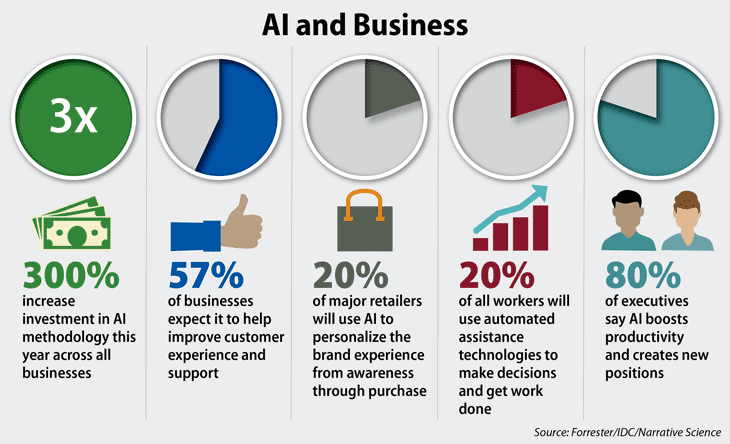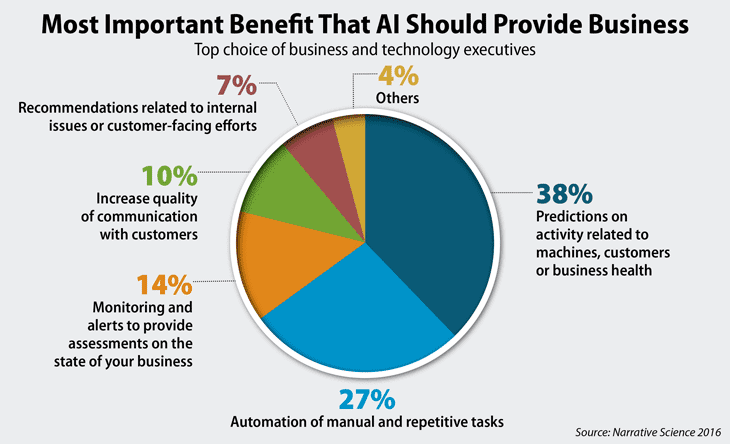Artificial intelligence (AI) in business is rapidly becoming a commonly-used competitive tool. Clearly, companies are past debating the pros and cons of AI. From better chatbots for customer service to data analytics to making predictive recommendations, deep learning and artificial intelligence in their many forms is seen by business leaders as an essential tool.
That puts AI in the short-list of technologies that your company should not just be watching, but actively exploring how to take advantage of. It joins leading emerging technologies like Machine Learning, cloud computing and Big Data.
If you aren’t convinced that AI is ready to handle a growing number and range of tasks, consider IBM’s Watson’s 2011 winning performance on Jeopardy. Or consider the various ways you are likely already using AI-enabled devices and services in your personal life, like smart assistant apps or devices like Amazon’s Alexa or Apple’s Siri. Not to mention other AI-supercharged apps, such as whatever GPS app you use while driving.
Here’s a quick look at how your competitors are already using AI in their business, and some advice on how to get on board.
Jump to:

Results of a recent survey indicate that artificial intelligence can assist businesses in areas ranging from customer support to personalization.
Examine How Your Competitors are Using AI
Odds are you can’t just call up your competitors and ask how they are using AI in their company. But thanks to the Internet, you can find out a lot of what they have said. For example, web-searching “how is Staples using AI” yields informative results from about how that company is putting artificial intelligence technology to work for itself.
Next, check your competitors’ web sites and social media presences (notably LinkedIn and Facebook). Browse their press releases, news coverage, and blogs. You might even go old-school, and get any hardcopy newsletters, annual reports or other literature from the past year that might not be available online.
Then cast a wider net, with an industry search, like “how are hospitals using AI,” “how are grocery stores using AI,” or even a more general search.
For example, when I did a search for “using AI in my business,” I got various hits talking about business uses for AI including:
- Improve customer decision management
- Improve QA for software and manufacturing
- Read medical imaging such as head CT scans.
Another suggestion: research how other parts of your supply chain – parts, shipping, support, and the like – are using AI.
Don’t forget other IRL (In Real Life)/non-digital avenues. If you are going to an industry event, look for AI-related sessions. Chat up whoever you’re standing or sitting near. And, of course, you could always read a book or two – although, by definition, that advice will be at least six to twelve months out of date.
If you know anybody at one or more competitors who’s informed and amenable, buy them a lunch and pick their brain.

Businesses have high hopes that AI can help them predict a wide array of activities.
Decide what AI Can Do for Your Business
Based on your research, you should be able to build a list and frame a sense of what AI can do for businesses in general, and for companies in your industry and of your size.
You’ll find several major key areas:
- Types of AI technology, like machine learning, deep learning, natural language processing, and cognitive computing. Understanding what these are and the different types of data and tasks each is good for should help you get a better grasp on AI, and understand the requirements and limits of various goals.
- What kinds of processing AI can do used for, such as image and speech recognition, predictive analytics. This will help give you a general sense of what AI is being put to use for, not just by businesses, but also government, education, science and other researchers, and others.
- Use Cases: what specific tasks these capabilities can help with, such as smart agents (for phone, chatbots, and more), optimizing inventory orders, anticipating machine or system failures, identifying computer threats, spotting fraudulent customer activity.
Based on this list, your next step is to come up with a short list of how artificial intelligence can help your business – specific tasks and use cases.
To help make this list:
- Decide what kinds of benefits you are looking for – improved employee productivity? faster workflow? improved product productivity? Reducing costs?
Then, prioritize that list based on a mix of estimated costs, time to implement, risk/benefit, and overall value.
In parallel, select one or two smaller tasks for trying artificial intelligence for your business. This could be a small piece of a larger task. Important: start with a task that is not business-critical. Another quick tip: Start with tasks that aren’t customer-facing.
Search for and Compare Vendors
Now it’s time to identify potential technology vendors. There is no shortage of top artificial intelligence companies.
In order to find and compare vendors, you first have to assess how you might add artificial intelligence capabilities to your company’s IT, which in turn depends on factors like:
- Size and depth of your IT staff (and budget). Do you already have any AI expertise in-house? Are there developers (along with QA and Ops) who can add AI chops? Does your IT staff have the time and resources to add AI to your existing business IT? To research, propose, and develop new AI-based business initiatives?
- Do any of your IT providers offer AI extensions, modules, tools, features, etc.
Vendors for AI capabilities spans several categories:
- Vendors that have added AI capabilities to their offerings. This includes everyone from Amazon, Apple and Google to IBM, Intel, and SalesForce, so you’ll need to decide whether you are planning to do this with hardware you own/buy, or cloud resources (or both).
- Vendors of specific AI capabilities, accessed through APIs or other methods.
For some of the AI you’re looking for, your current vendors may already offer. In other cases, you may outsource. For still others, you may end up doing internally. It all depends on what you want, how much developer bandwidth you have in-house, and how you provision your IT operations.
Your best bet will be to find one or more AI experts, either internally, or outside consultants. For the latter, start with ones who aren’t part of a vendor… unless the vendor is offering AI that is a match for your criteria.
Implement the AI Project
Once you have identified your initial AI projects the real fun begins: implementation. Essential milestones:
- First, you need to put together a plan, stating the specific and general goals, milestones scheduling, estimated hard and soft costs, and the resources needed, including people skills, hardware and software.
- Identify who will be impacted, including existing resources, suppliers, users/customers. Be aware of who should benefit, along with including possible negative impact during implementation.
- Set goals for the project’s benefits. This includes determining how to measure results, and, if possible, how to A/B compare the AI-enabled approach and the prior methodologies.
- Don’t forget to include talking to the stakeholders, including users/customers. Ask their thoughts, preferences and suggestions, along with plans for training documents and sessions as the trials and operational versions become ready.
Key: Be ready to revisit constantly.
Just because you have AI projects out of development and testing, and contributing to your business, that doesn’t mean you’re done. Just as provisioning infrastructure or updating your company’s web and social presence is never done.
In addition to tracking your selected AI vendors for improvements, new features you want to stay on top of other AI developments. For example, what new capabilities have become available? What improvements in infrastructure performance or price make existing or new AI offerings now viable?
And, of course, you want to keep up with what others in your industry, and the AI vendors serving your industry, are doing or have on their road map.
Challenges and Pitfalls to Avoid
Adding AI your company’s operations and business is a big change, and likely a big transformation. Here’s some quick advice to lessen the challenges:
- Understand how the AI you’re buying works. What are its strengths? Weaknesses?
- What kind of IT environment does the AI require? More RAM? Newer hardware-level virtualization? Different memory or I/O, like moving to NVMe, or hyperconverged infrastructure?
- Are you feeding your AI apps too much data? Too little? The wrong data? Are you asking them the right questions?
- Look for AI tools that will give clear, actionable alerts or other results, rather than endless pages of mostly-unimportant findings.
Plus, focus on AI that’s available as a supported product/service, rather than something still in development.
Future Trends to Watch
Although AI as an area within computer science dates back to the 1950’s, it’s only been within the past decade that many types of AI have become available to companies of all sizes.
This is thanks to factors like continuing hardware price/performance improvements, cloud computing, and advances in AI techniques. At the same time, computing trends like big data, IoT, self-driving vehicles, and speech and image recognition are generating more “targets” to point AI tools at.
In particular, Keep an eye on cloud costs and capabilities, along with what the various players are doing or talking about, AI-wise. Like nearly everything involving computer technology, many of the next cool capabilities can’t be anticipated or predicted. Bottom line: talk to professionals in your field – nothing will help you quite as much.
SEE ALL
ARTIFICIAL INTELLIGENCE ARTICLES









